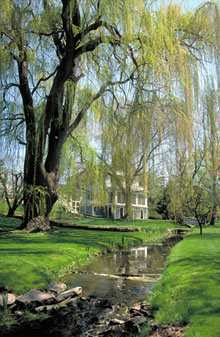NOTL Exploring the Past
First Nations & Aboriginals - An Introduction

Niagara-on-the-Lake's history is fascinating, even for those not naturally curious about exploring the past.
The area was first settled by Native people over 11,000 years ago. Nomadic hunters and gatherers, the Natives eventually made their settlement more permanent as they began cultivating crops in the fertile area. The Neutral Nation inhabited Niagara until they were overthrown by the Iroquois in 1650. With the demise of the Neutral Nation, the area was briefly settled by the Seneca and Mississauga Nations.
Butlersburg was the name first given to the historic town by the British around 1781 which later became West Niagara. As well as First Nations people, Niagara-on-the-Lake was a primary destination for the United Empire Loyalists who fled to Canada in droves as a result of the American Revolution. It is estimated that 5,000 U.E.L. colonists left their homes, their lands and all their worldly possessions as they migrated north to present day Niagara-on-the-Lake to settle in British North America. Their loyalty to the Crown and the British system of government motivated them to flee the U.S.A. and make new homes and new lives north of the border. Nearly 80,000 refugees fled from America following the revolution.
Newark, as the little town was named in 1792 became the first capital of Upper Canada which was created on December 26th, 1791. John Graves Simcoe became the first Lieutenant Governor. Ever fearful of an American assault the Capital was moved to York, the present day Toronto in 1797 because it was further inland and less vulnerable to the threat of invasion. 1798 saw Newark re-named Niagara.
On June 18, 1812, the United States declared war on Great Britain and Niagara became a huge battleground for about three years. The little town fell under siege by the Americans near the end of the War of 1812. The invading army burned Niagara to the ground and there are only a few remaining buildings which survived the devastation. The historic buildings which abound in Niagara-on-the-Lake today are the result of the town being rebuilt by the British following the fire. The fate of Canada hung in the balance for those three years but at the end of the battling, the British were victorious and Canada was secure.
In 1831 the Niagara Harbour and Dock Company was founded and the little town prospered. By 1860, however, following the construction of the Welland Canal, the center of commerce and the county seat moved to nearby St. Catharines because of its location adjacent to the Canal. Niagara suffered through this depression and slowly started to convert farmland into orchards and thus began the legacy of the Niagara Fruitbelt. Preserving the past has always been a priority in Niagara and this pride in its past led to the beginnings of tourism in the area.
The town was renamed Niagara-on-the-Lake around 1880 to distinguish it from Niagara Falls which lay only 20 miles upstream on the Niagara River.



